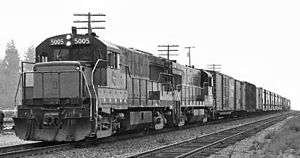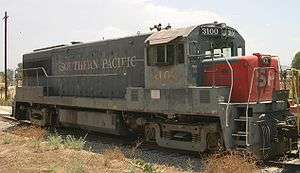GE U25B
| GE U25B | |||||||||||||
|---|---|---|---|---|---|---|---|---|---|---|---|---|---|
 | |||||||||||||
| |||||||||||||
| |||||||||||||
| |||||||||||||
| |||||||||||||
The GE U25B was General Electric's first independent entry into the United States domestic Diesel-electric locomotive railroad market for heavy production road locomotives since 1936. From 1940 through 1953, GE participated in a design, production, and marketing consortium (Alco-GE) for diesel-electric locomotives with the American Locomotive Company. Starting in 1956 GE launched its Universal Series of diesel locomotives for the export market. The U25B was the first attempt at the domestic market since its termination of the consortium agreement with Alco.
History
The U25B (nicknamed U-Boat) was the first commercially successful domestic diesel electric road locomotive designed, built, and sold by General Electric after its split with the American Locomotive Company (Alco), a company dating back to the steam era. GE had developed internal combustion-electric generating, control, and drive systems in the early 1920s, which provided the foundation for the use of internal combustion engines in railroading. Early applications were in motorized railcars and switch engines. The 1930s saw that technology adapted to high speed mainline locomotives. In 1940 GE partnered with Alco, who by that time were well-established as a manufacturer of Diesel switch engines and were introducing their first Diesel road locomotives. They were successful in building locomotives for switching and short-haul applications, having introduced the first road-switcher design in 1941 (which would supplant the carbody design developed by the Electro-Motive Corporation by the mid-1950s) and gained about a 40% market share during the Dieselization era. Alco-GE's efforts in main line road locomotives had not been successful at breaking into EMD's dominant position in that market, although they introduced a successful gas turbine-electric locomotive to market in 1952. In 1953 GE went independent from Alco in locomotive production, with their new subsidiary GE Rail taking over the gas turbine-electric venture while they sought a supplier of more reliable Diesel engines suitable for road locomotives. Production of Cooper-Bessemer powered Universal Series locomotives began in 1956 and some 400 export locomotives were sold before the U25B was offered in the United States. The U25B was announced by General Electric as a domestic model on April 26, 1960. It was the first locomotive powered by GE's highly successful FDL-16 engine.
The U-Boat put GE on the road to becoming the top locomotive producer in the U.S., much to the chagrin of EMD. It introduced many innovations to the U.S. diesel locomotive market, including a pressurized car body and a centralized air processing system that provided filtered air to the engine and electrical cabinet, thus reducing maintenance. The U25B was also the highest-horsepower four-axle diesel road locomotive in the U.S. at the time of its introduction, its contemporaries being the GP20 (2,000 hp) and the RS27 (2,400 hp or 1,800 kW).
Though many were produced and sold, the only remaining U25B locomotives are in museums, as many were retired or scrapped at the end of their service life by the end of the 1980s.
Rebuilds
Four Southern Pacific U25Bs were rebuilt by Morrison-Knudsen with a Sulzer V-12 prime mover. These locomotives, designated M-K TE70-4S, operated from 1978–1987.[1]
Preservation
Only one remains in operating condition. Southern Pacific 3100 is now on permanent exhibit at the Orange Empire Railway Museum in Perris, California. Built in 1963, this locomotive was first numbered SP 7508. Later numbered SP 6800, it became a goodwill ambassador for the railroad in 1976 when it was painted in an elaborate red, white, and blue color scheme in celebration of the nation's bicentennial; it was later renumbered and repainted in standard SP livery and was donated to the museum. The 3100 is fully certified to run on any of the nation's railroads and is frequently used as motive power for offsite work trains.
 The 3100 is the only GE U25B still in working order.
The 3100 is the only GE U25B still in working order. The 3100 is on display at the Orange Empire Railway Museum.
The 3100 is on display at the Orange Empire Railway Museum. The manufacturer's plate on the 3100.
The manufacturer's plate on the 3100.
A second U25B locomotive is currently undergoing restoration efforts at the Illinois Railway Museum in Union, IL. Former Milwaukee Road engine number 5056 (built in 1965) is being both cosmetically and mechanically restored for operation on the museum grounds.
Milwaukee Road 5057 is being cosmetically restored by Cascade Rail Foundation to eventually be displayed at the South Cle Elum Rail Yard in Washington. [2]
New York Central #2500 is on display at the Lake Shore Railway Historical Society museum in North East, Pennsylvania.
Conrail 2510 was to be preserved by The Great Northeastern Rail Road Foundation, but the plans fell through and the engine is sitting in rough shape, in Glenmont, NY. It is currently owned by the National Railway Historical Society. It was built as New York Central 2510 in May 1964.
New York, New Haven & Hartford #2525 has been preserved by the Railroad Museum of New England/Naugatuck Railroad of Thomaston, CT. It wears its original New Haven colors, however it is not currently operational.
Original owners
| Railroad | Quantity | Numbers | Notes |
|---|---|---|---|
| General Electric (XP-24 testbed) | 2 | 751–752 | Never sold, retained by GE |
| General Electric (demonstrator) | 4 | 753–756 | High short hood; to Frisco 804–807 |
| 4 | 2501–2504 | to Union Pacific 633–636 | |
| 5 | 51-55 | to Frisco 812, 815, 814, 813, and 811. | |
| Atchison, Topeka and Santa Fe Railway | 16 | 1600–1615 | renumbered 6600–6615 |
| Chesapeake and Ohio Railway | 38 | 2500–2537 | renumbered 8100–8137 |
| Chicago, Burlington and Quincy Railroad | 6 | 100–105 | to Burlington Northern 5424–5429 |
| Chicago, Milwaukee, St. Paul and Pacific Railroad ("Milwaukee Road") | 12 | 380–391 | 380 retired 1966; remainder renumbered 5000–5010; renumbered 5050–5060 |
| Chicago, Rock Island and Pacific Railroad | 39 | 200–238 | 225–238 to Maine Central Railroad 225–238 |
| Erie Lackawanna Railroad | 27 | 2501–2527 | to Conrail 2570–2596 |
| Great Northern Railway | 24 | 2500–2523 | to Burlington Northern 5400–5423 |
| Louisville and Nashville Railroad | 27 | 1600–1626 | |
| New York Central Railroad | 70 | 2500–2569 | to Penn Central 2500–2569; to Conrail 2500–2569 |
| New York, New Haven and Hartford Railroad | 26 | 2500–2525 | to Penn Central 2660–2685; to Conrail 2660–2685 |
| Norfolk and Western Railway | 1 | 3515 | renumbered 8138 (wreck replacement for Wabash unit) |
| Pennsylvania Railroad | 59 | 2500–2548, 2649–2658 | renumbered 2600–2658; to Penn Central 2600–2658; to Conrail 2600–2658 |
| St. Louis – San Francisco Railway ("Frisco") | 23 | 800–803, 808–810, 816-831 | 804–807, 811-815 ex GE. Numbers 800–807 were high short hood units in black and yellow scheme; The next set (808–815) were low short hood units in black and yellow. The last 16, 816-831, were low hoods and delivered in the orange and white scheme. To Burlington Northern 5210–5233. |
| Southern Pacific Company | 68 | 7500–7567 | renumbered 6700–6767 |
| Union Pacific Railroad | 12 | 625–632, 637–640 | 633–636 ex GE demonstrators 2501-2504. The only railroad, other than the Frisco, to have high short hood U25Bs. |
| Wabash Railroad | 15 | 500–514 | to Norfolk and Western 3516–3529; renumbered 8139–8152 |
| Total | 478 |
Notes
References
- Marre, Louis A. (1995). Diesel Locomotives: The First 50 Years: A Guide to Diesels Built Before 1972. Railroad Reference Series. Waukesha, Wisconsin: Kalmbach Publishing. ISBN 978-0-89024-258-2.
- Komanesky, John. "General Electric U25B Roster". Extra 2200 South. Retrieved January 27, 2005.
- Lustig, David (May 2003). "Whatever happened to SP's 'Popsicles'?". Trains. 63 (5): 23. ISSN 0041-0934.
- Pinkepank, Jerry A. (1973). The Second Diesel Spotter's Guide. Milwaukee, Wisconsin: Kalmbach Publishing. ISBN 978-0-89024-026-7.
- "What's up with the U25B" pp 40-41 Trains Magazine August 1960.